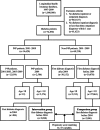Impact of pay-for-performance on mortality in diabetes patients in Taiwan: A population-based study
- PMID: 27399144
- PMCID: PMC5058873
- DOI: 10.1097/MD.0000000000004197
Impact of pay-for-performance on mortality in diabetes patients in Taiwan: A population-based study
Abstract
Background: The impact of pay-for-performance (P4P) programs on long-term mortality for chronic illnesses, especially diabetes mellitus, has been rarely reported. Several studies described the favorable impact of P4P for diabetes mellitus on medical utilizations or intermediate outcomes. Therefore, this study aimed to investigate the impact of a P4P program on mortality in patients with type 2 diabetes.
Methods: The P4P group in this population-based cohort study was 2090 individuals with a primary diagnosis of type 2 diabetes who had been newly enrolled in the P4P program of Taiwan between January 1, 2004 and December 31, 2004. Matched by 1:1 ratio, patients in the non-P4P group were selected by propensity score matching (PSM) for sex, age, the first year of diagnosis as diabetes, and 32 other potential confounding factors. Mean (SD) age was 60.91 (12.04) years when diabetes was first diagnosed and mean (SD) duration of diabetes was 4.3 (1.9) years at baseline. The time-dependent Cox regression model was used to explore the impact of P4P on all-cause mortality.
Results: During a mean of 5.13 years (SD = 1.07 years) of follow-up, 206 and 263 subjects died in the P4P group and the non-P4P group, respectively. After adjusting for the potential confounding factors at baseline, survival was significantly longer in the P4P group than in the non-P4P group (hazard ratio, 0.76 [95% confidence interval, 0.64-0.92], P = 0.004, by log-rank test). This decrease in mortality is equivalent to one less death for every 37 patients who were treated in the P4P program for 5.13 years. In this study, the P4P program significantly increased the medical utilization of physician visits and diabetes-related examinations, improved the adherence of oral hypoglycemic drugs during the first 3 years and that of insulin during the second 3 years, and was negatively associated with risk of cancer and chronic kidney disease. In annual health expense, there was no significant difference between P4P and non-P4P groups, P = 0.430.
Conclusions: As compared with control, pay-for-performance program significantly improved survival in patients with diabetes without increasing the medical cost. The P4P group had significantly lower risk of cancer and chronic kidney disease.
Conflict of interest statement
The authors have no conflicts of interest to disclose.
Figures



References
-
- Diabetes care and research in Europe: the Saint Vincent declaration. Diabet Med 1990; 7:360. - PubMed
-
- Huang J, Yin S, Lin Y, et al. Impact of pay-for-performance on management of diabetes: a systematic review. J Evid Based Med 2013; 6:173–184. - PubMed
-
- Epstein AM, Lee TH, Hamel MB. Paying physicians for high-quality care. N Engl J Med 2004; 350:406–410. - PubMed
-
- Doran T, Fullwood C, Gravelle H, et al. Pay-for-performance programs in family practices in the United Kingdom. N Engl J Med 2006; 355:375–384. - PubMed
-
- Lee TT, Chen CC. A pay-for-performance program for diabetes care in Taiwan: a preliminary assessment. Am J Manag Care 2010; 16:65–69. - PubMed
MeSH terms
LinkOut - more resources
Full Text Sources
Other Literature Sources
Medical
Molecular Biology Databases
Research Materials
Miscellaneous

